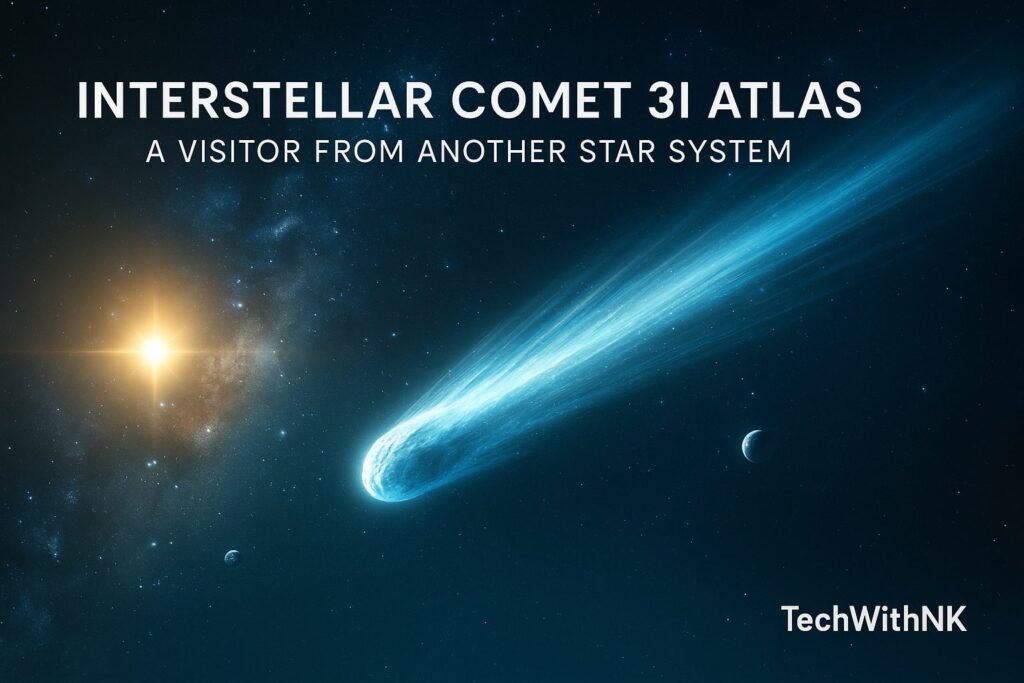🪐 Introduction – When the Stars Send a Visitor
In July 2025, astronomers made a breathtaking discovery — a bright, icy object entering our Solar System on a hyperbolic trajectory, meaning it wasn’t coming back. It wasn’t from our Sun’s family at all. This was interstellar comet 3I ATLAS, only the third known object from another star system to pay us a visit.
The term interstellar means it originated in the space between stars, beyond the gravitational boundary of the Sun. 3I ATLAS, named after the telescope that spotted it — ATLAS (Asteroid Terrestrial-impact Last Alert System) — has become one of the most exciting cosmic events of 2025.
This article dives deep into every detail: its discovery, composition, speed, visibility, and scientific importance — all explained in a way that every TechWithNK reader can grasp.
🔭 Discovery of Interstellar Comet 3I ATLAS
Date of discovery: 1 July 2025
Discovered by: ATLAS telescope, Chile (University of Hawai‘i Institute for Astronomy project)
Astronomers noticed an unusually fast-moving point of light against the background stars. The orbit didn’t fit any known Solar System family. After further measurements, the Minor Planet Center confirmed that it was on a hyperbolic trajectory — a sure signature of interstellar origin.
This discovery made 3I ATLAS the third confirmed interstellar object, after:
1️⃣ 1I/ʻOumuamua (2017) – an elongated, tumbling body.
2️⃣ 2I/Borisov (2019) – a classic comet from another star system.
3️⃣ 3I/ATLAS (2025) – our new cosmic guest.
Each of these has reshaped how scientists view material exchange between star systems.
☄️ What Makes It “Interstellar”?
Most comets orbit the Sun in long ellipses. Interstellar comet 3I ATLAS, however, follows a hyperbola — mathematically meaning it will never return.
Its eccentricity (a measure of how stretched an orbit is) is greater than 1, proving it’s unbound from the Sun. Astronomers calculate its inbound velocity at about 26 km/s, and outbound velocity at about 61 km/s, after solar acceleration — an immense speed confirming it isn’t gravitationally trapped.
In simpler terms:
Normal comets = boomerangs (they come back).
3I ATLAS = a straight-through traveller from another world.
🔹 Orbital Path and Timeline
| Event | Date (2025) | Distance |
|---|---|---|
| Discovery by ATLAS | 1 July | — |
| Perihelion (closest to Sun) | 29 October | 1.36 AU ≈ 203 million km |
| Closest approach to Earth | 19 December | 1.8 AU ≈ 270 million km |
| Exits Solar System plane | Mid-2026 | — |
After perihelion, 3I ATLAS will head outward toward the constellation Perseus, eventually leaving the Solar System forever — carrying with it the cosmic dust of another sun.
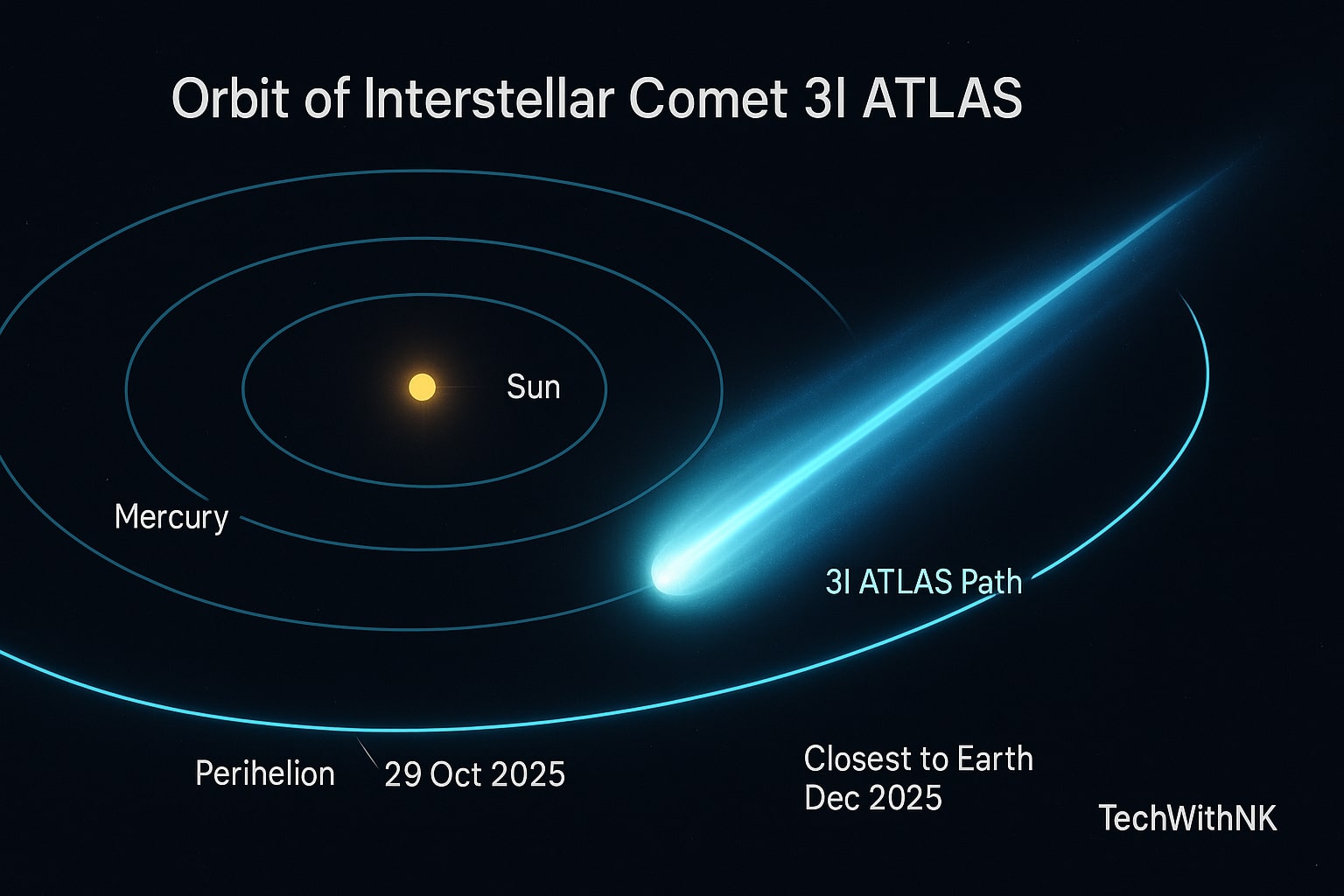
🧊 Composition – What Is 3I ATLAS Made Of?
Spectral analysis by the James Webb Space Telescope (JWST) and SPHEREx mission revealed something surprising:
Extremely high carbon dioxide (CO₂) content.
Unusual ratios of CO₂ : H₂O : CO, different from typical Solar System comets.
A dusty coma with fine carbon-rich grains.
This suggests interstellar comet 3I ATLAS formed in a colder or more chemically diverse region than our own cometary nursery, perhaps near the icy outer disk of another stellar system billions of years ago.
Nucleus Size
Observations estimate the nucleus to be ≤ 5.6 km, though some Hubble analyses narrow it closer to ~300 m. Its small but active surface still ejects dust and gas as sunlight warms it — forming a coma and a faint tail.
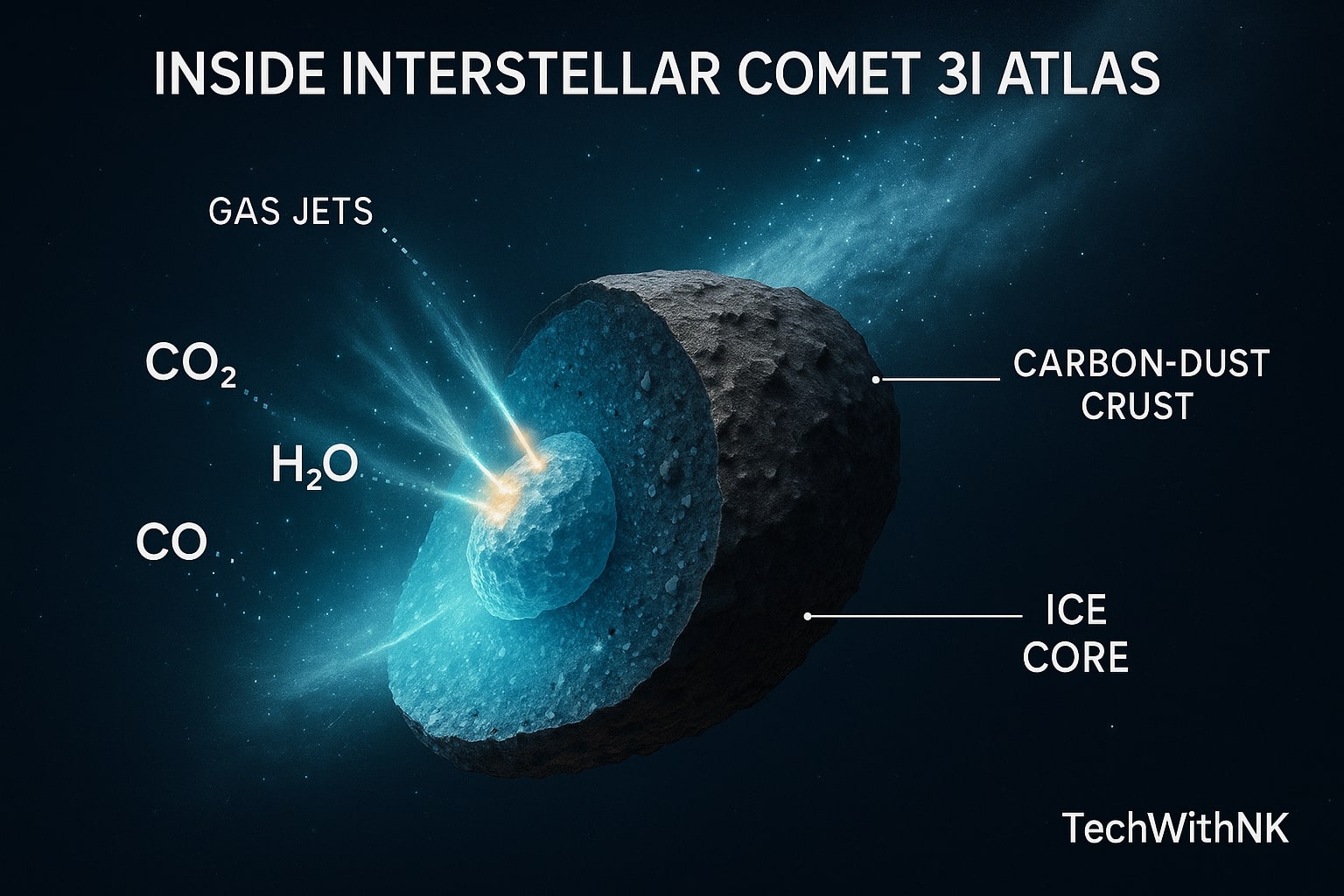
💨 Interstellar Comet 3I ATLAS Speed
Speed is what truly separates this visitor from the rest.
Inbound speed: ~26 km/s (93,600 km/h) relative to the Sun.
At perihelion: ~61 km/s (220,000 km/h).
Escape velocity after Solar passage: > 55 km/s as it leaves.
At such velocity, 3I ATLAS would cross the entire distance between Earth and Moon in under 2 hours!
For comparison:
Voyager 1 spacecraft → 17 km/s
2I/Borisov → 33 km/s
1I/ʻOumuamua → 38 km/s
That makes interstellar comet 3I ATLAS the fastest natural interstellar object ever observed.
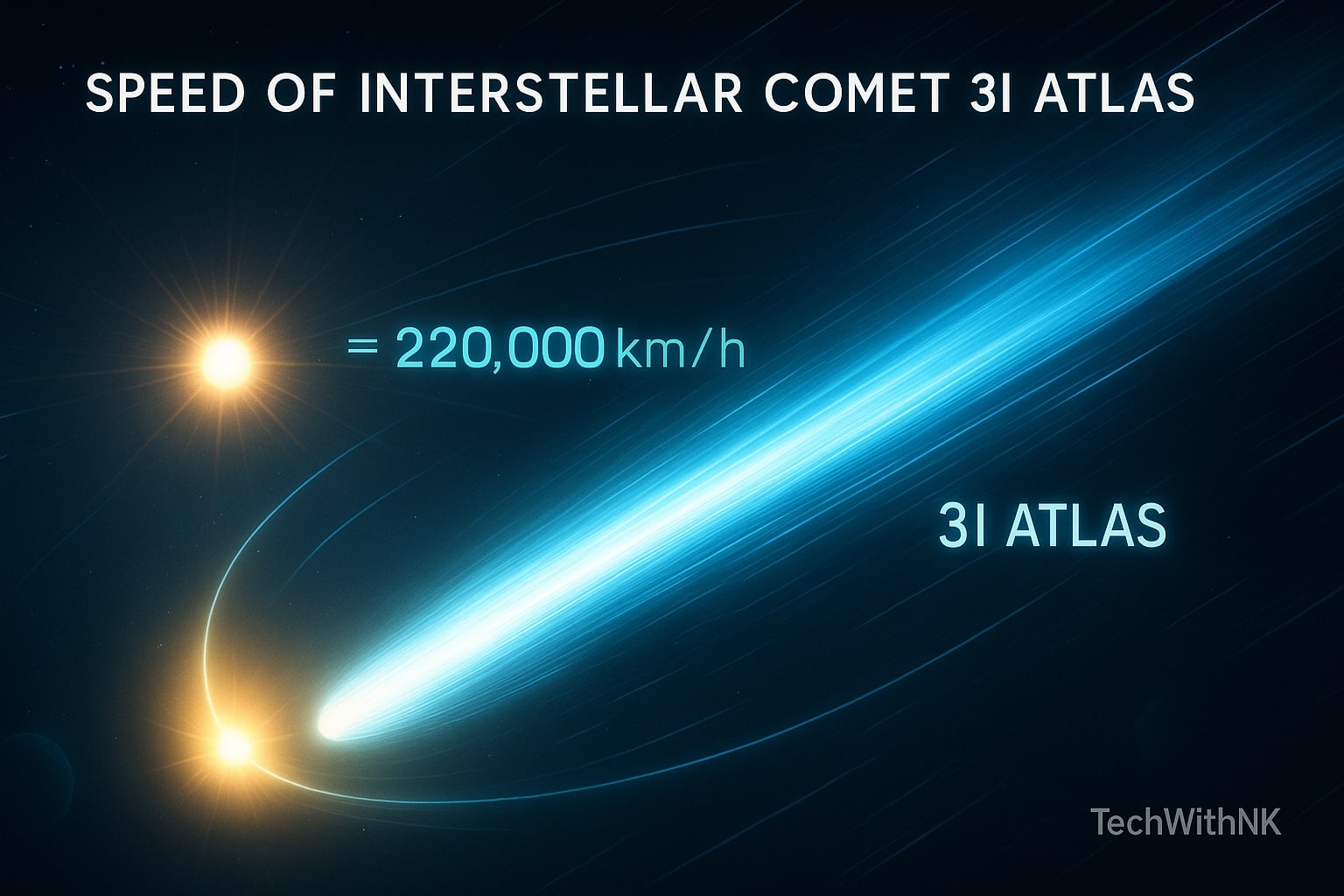
🌞 How Long Will Comet ATLAS Be Visible?
Many wonder: how long will comet ATLAS be visible?
Unfortunately, despite being scientifically exciting, 3I ATLAS will not become a bright naked-eye spectacle. Its brightness (magnitude ≈ 12–13) means it’s visible only through medium-to-large amateur telescopes.
Visibility Timeline (2025–2026):
July–September 2025: Faint (mag 17 → 13) — visible only to professional telescopes.
October 2025 (perihelion): Temporarily obscured by Sun’s glare.
November–December 2025: Brief re-appearance in early morning skies, mag ≈ 12.
Early 2026: Rapidly fades as it exits Solar System plane.
So, interstellar comet 3I ATLAS will likely be visible for around 4–5 months through telescopes before vanishing forever into interstellar darkness.
🧪 What Scientists Hope to Learn
Studying this comet offers scientists a one-of-a-kind laboratory:
Chemical fingerprint of another star system – revealing how distant worlds form ices and organics.
Evolution of interstellar matter – how cosmic radiation alters comets over billions of years.
Exchange between stars – confirming that planetary systems eject debris that travels through the galaxy, potentially seeding life elsewhere.
Mission feasibility – 3I ATLAS’s path inspires planning for future intercept missions (like ESA’s Comet Interceptor).
In other words, 3I ATLAS is a messenger from another world — carrying the chemistry of a distant sun.
🧭 Comparison with Previous Interstellar Visitors
| Feature | 1I/ʻOumuamua (2017) | 2I/Borisov (2019) | 3I/ATLAS (2025) |
|---|---|---|---|
| Type | Asteroidal / metallic | Icy comet | Active comet |
| Origin | Unknown star system | Red dwarf region | Likely icy outer disk of foreign system |
| Shape | Elongated (cigar shape) | Classic coma & tail | Compact coma with unusual dust flow |
| Speed | ~38 km/s | ~33 km/s | ~61 km/s |
| Notable Feature | No coma | Water + dust tail | High CO₂ composition & “back-to-front” tail |
Each new interstellar visitor deepens our understanding of cosmic traffic between stars.
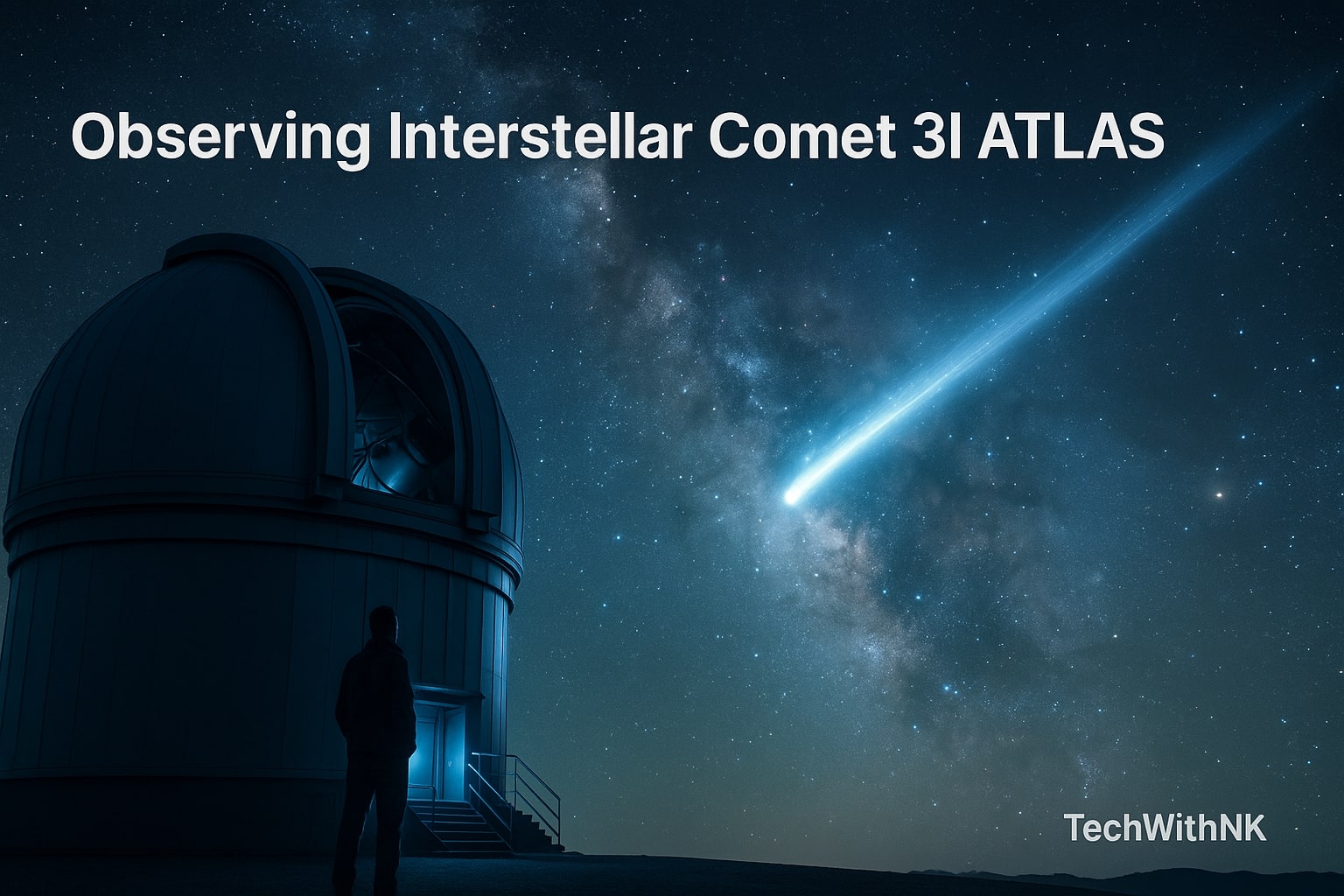
🧬 Why “Back-to-Front” Tail?
Images from the Very Large Telescope and Hubble surprised astronomers: the dust tail of interstellar comet 3I ATLAS pointed slightly toward the Sun instead of away.
This anomaly might result from non-uniform outgassing, where jets on the comet’s surface push dust in odd directions. It could also reflect its unfamiliar composition reacting differently to solar radiation.
This unique behaviour confirms that 3I ATLAS is unlike any comet native to our Solar System.
🛰️ Possible Missions & Future Research
Although no spacecraft can reach it now, 3I ATLAS has re-ignited interest in rapid-launch interceptors. Agencies like NASA, ESA, and ISRO are evaluating “ready-to-launch” comet chaser concepts that could catch future interstellar visitors within 1–2 years of discovery.
The Comet Interceptor Mission (ESA + JAXA) launching in 2029 will wait near L2 point for a future target — possibly the next interstellar comet. 3I ATLAS is thus shaping future space mission design.
🌌 Scientific Significance
First direct sample of material from another star system (via spectrometry).
Proof that interstellar objects are more common than previously thought.
Insight into cosmic mixing — building blocks of planets may roam freely through the galaxy.
Potential clue to panspermia — how life’s ingredients travel between stars.
Every observation of interstellar comet 3I ATLAS adds to humanity’s understanding of our place in the Milky Way.
🧠 Quick Facts Table
| Parameter | Value |
|---|---|
| Official Name | 3I/ATLAS |
| Discovery Date | 1 July 2025 |
| Type | Interstellar Comet |
| Closest to Sun | 29 Oct 2025 @ 1.36 AU |
| Closest to Earth | 19 Dec 2025 @ 1.8 AU |
| Speed at Perihelion | ~61 km/s (≈ 220,000 km/h) |
| Visibility Duration | ~4–5 months (through telescopes) |
| Composition Highlights | High CO₂ , carbon dust |
| Future Path | Leaving Solar System → Interstellar space by 2026 |
🌠 Conclusion – A Visitor We’ll Never See Again
Interstellar comet 3I ATLAS is more than a distant ball of ice; it’s a time capsule from another star system. At over 220,000 km/h, it will soon vanish forever into interstellar space, leaving scientists with precious data.
Even though we may not see it with the naked eye, its discovery reminds us that our Solar System is not isolated — stars exchange matter across light-years.
For the engineers and astronomers of the future, 3I ATLAS is both a challenge and an invitation: build faster missions, open wider eyes, and be ready when the next messenger arrives.
What is interstellar comet 3I ATLAS?
It’s the third confirmed interstellar object, discovered in 2025, entering our Solar System from deep interstellar space.
How fast is interstellar comet 3I ATLAS?
At perihelion, it travels ~61 km/s (≈ 220,000 km/h) — faster than any known natural comet.
How long will comet ATLAS be visible?
It should remain visible to telescopes for 4–5 months (from July 2025 to January 2026) before fading.
Can we see 3I ATLAS with the naked eye?
No — its brightness stays too low for unaided viewing; powerful telescopes are required.
